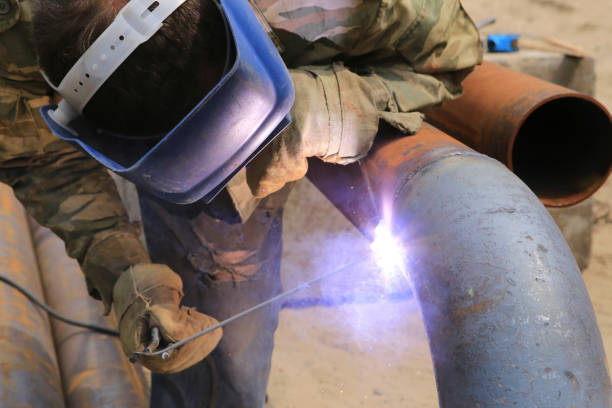I guess you may also have found that there's a common issue that many practitioners face in the welding processes — air leaks at the welded joints. These leaks can lead to significant problems, including reduced product performance, safety hazards, and increased costs. If you find yourself facing air leakage in your weld connections, it’s crucial to understand the underlying causes and the steps you can take to fix this issue.

I. Make Clear Causes of Leakage.
Before delving into solutions, it's important to understand why air leaks occur at welded joints. Several factors can contribute to this problem, including:
Poor Weld Quality: Inconsistent weld penetration or insufficient filler material can create gaps that allow air to escape.
Incorrect Welding Technique: Using the wrong welding technique can lead to inadequate fusion between the base materials, resulting in weak spots at the joints.
Material Contamination: Oils, dirt, and moisture on the metal surfaces can prevent proper fusion during the welding process, causing leaks.
Inappropriate Equipment Settings: The wrong heat settings, speed, or voltage can lead to weld defects that create pathways for air to leak.
Type of Joint Design: Some joint designs are more susceptible to leaks than others. A poor design might create stress points that can lead to cracking over time.
Understanding these factors is the first step toward addressing air leaks in your welded joints.
II. Identifying the Source of Leakage.
The next step is to identify the specific source of the leak. Performing a thorough inspection can help pinpoint the problematic areas. Here are some methods to assess the integrity of your welds:
Visual Inspection: The first line of defense is a careful visual inspection. Look for any obvious signs of defects such as cracks, holes, or uneven surfaces in the weld.
Dye Penetrant Testing: This method uses a dye to highlight flaws in the weld. After applying the dye, it is necessary to clean the surface, and the dye will seep into any cracks or pores. Applying a developer reveals the extent of the leakage.
Pressure Testing: If applicable, subjecting the welded assembly to pressure can help detect leaks. If the pressure drops, this indicates that there is a leak somewhere in the system.
Ultrasonic Testing: This non-destructive testing method uses high-frequency sound waves to detect imperfections in the weld without damaging the material.
Identifying the source of the leak is crucial in determining the most effective repair strategy.
III. Fixing the Leakage.
Once you have pinpointed the problem areas, the next step is to decide on the appropriate approach to fix the leaks. Here are several strategies you can consider:
1. Re-Welding:
If the leaks are due to poor welds, re-welding may be the most effective solution. Use proper techniques to ensure good penetration and fusion between the materials. Adjust welding parameters such as voltage and speed to suit the materials and thickness involved. Additionally, make sure to clean the surfaces thoroughly before welding to remove any contaminants that could hinder the process.
2. Sealants:
For minor leaks, applying a sealant might be a quick and effective solution. Materials such as epoxy or silicone sealants can fill small voids and prevent air from escaping. However, keep in mind that this is a temporary fix and should not replace proper welding.
3. Gaskets and O-Rings:
In a situation where welding cannot provide a guarantee against air leaks, consider incorporating gaskets or O-rings at the joint. These components can provide a defensive barrier against leakage, particularly in mechanical assemblies or duct systems.
4. Using a Vacuum Pressure Test:
After making repairs, consider performing a vacuum pressure test to ensure that the welding issues have been resolved. This test will help confirm that the joint is airtight, and you can proceed with confidence.
IV. Preventing Future Leakage.
Prevention is always better than cure. To avoid air leaks in the future, consider the following strategies:
1. Quality Control:
Implement a robust quality control system to assess the integrity of the welds during and after the welding process. Regular inspections can prevent leaks before they become problematic.
2. Training and Skills Development:
Invest in ongoing training for welders to ensure they are up-to-date on the best practices and techniques. Skilled welders are less likely to produce defective joints.
3. Choose the Right Materials:
Ensure that you are using compatible materials for the welding process. Understanding the properties of the materials and selecting the appropriate filler material is crucial to achieving strong welds.
4. Maintain Equipment:
Regular maintenance of welding equipment is essential for achieving optimal performance. Ensure that all equipment is calibrated correctly and replaced when necessary.
V. Conclusion.
Dealing with air leaks in welded joints can be frustrating, but understanding the root causes and implementing effective solutions can help. By identifying the leaks, applying the right fixes, and putting measures in place to prevent recurrence, you can ensure that your welded products perform reliably and safely.
Addressing air leaks not only enhances the integrity of your product but also contributes to the overall quality of your organization’s output. Remember, a proactive approach to welding quality can save time, reduce costs, and enhance safety in your operations. Take the necessary steps to ensure your welds are airtight, and your products will benefit in the long run.
Related articles:
1. Solutions to Oil Leakage in Pipeline Continuous Laser Welding
2. Porosity in Welding: Causes, Types, Effects and Solutions
3. How to Avoid Porousness in TIG Welds?
4. Megmeet Supporting the 9th China Welding Technology Development Forum of Shipbuilding and Marine Engineering
5. Risk-free Welding: Why is Welding Fume Extraction so Important?




